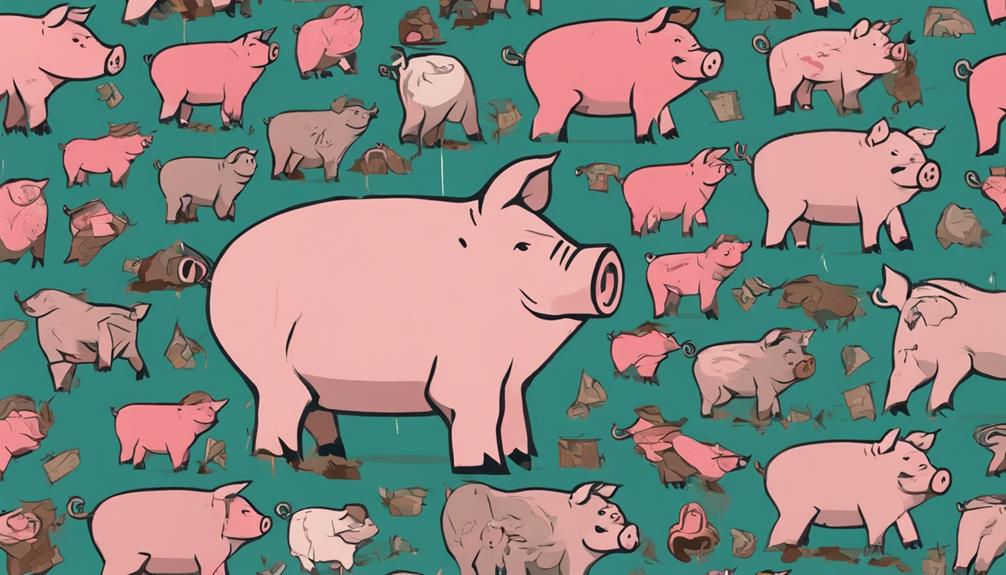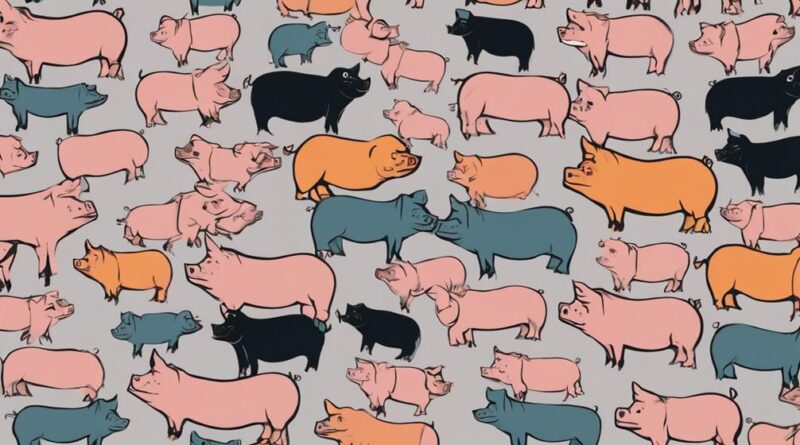Why Is Genetic Diversity Crucial in Pig Species?
Have you ever pondered the intricate tapestry that genetic diversity weaves within pig species?
The genetic makeup of pigs holds a key to their resilience and overall well-being.
As you explore the importance of genetic diversity in these animals, you will uncover a myriad of crucial reasons that extend far beyond mere survival.
The balance of various genetic traits within pig populations plays a pivotal role in ensuring their future sustainability and adaptability to changing environments.
Importance of Genetic Diversity
Genetic diversity plays a crucial role in ensuring the resilience and long-term survival of pig species. Through strategic breeding programs, farmers can harness the power of genetic variation to enhance desirable traits in pigs. By carefully selecting breeding pairs with diverse genetic backgrounds, farmers can promote hybrid vigor, leading to offspring that exhibit improved growth rates, disease resistance, and overall health.
Breeding programs that prioritize genetic diversity help prevent inbreeding, which can lead to a host of health issues and genetic abnormalities within pig populations. By introducing genetic variability through diverse breeding pairs, farmers can mitigate the risks associated with a limited gene pool. This variability not only enhances the overall health and well-being of pigs but also contributes to the sustainability of pig species in the long run.
Hybrid vigor, a phenomenon where crossbred offspring outperform their purebred parents, is a direct result of genetic diversity. Through intentional crossbreeding, farmers can capitalize on the benefits of hybrid vigor to improve the productivity and efficiency of their pig herds. By incorporating genetic diversity into their breeding programs, farmers can unlock the full potential of pig species, ensuring their adaptability and success in various environmental conditions.
Impact on Disease Resistance
To understand how genetic diversity influences disease resistance in pig species, consider the direct impact on their ability to combat pathogens and illnesses effectively. Genetic selection plays a crucial role in determining the diversity within a population, influencing the range of immune responses that pigs can exhibit. When a population has high genetic diversity, there's a higher chance of some individuals possessing genetic traits that make them more resilient to certain diseases. This variability in immune responses can be advantageous when facing new or evolving pathogens, as some pigs may naturally have the ability to resist or recover from infections better than others.
Furthermore, genetic diversity can prevent the spread of diseases within a population. If all pigs have similar genetic backgrounds, they may all be susceptible to the same illnesses. In contrast, a genetically diverse population is more likely to have some individuals that are resistant to specific diseases, serving as a barrier to the rapid transmission of pathogens. This is especially important in pig farming, where diseases can spread quickly and devastate entire herds.
Enhancing Reproductive Performance
Improving reproductive performance in pig species involves implementing strategies that maximize breeding efficiency and overall herd productivity. Enhancing fertility is a key aspect of improving reproductive performance in pig species. By focusing on improving fertility rates, you can ensure a higher success rate in breeding and ultimately increase the productivity of your herd.
To enhance fertility, it's crucial to manage the breeding process efficiently. Monitoring the reproductive cycles of sows, ensuring proper nutrition, and providing a stress-free environment are essential factors in improving breeding efficiency. By optimizing these aspects, you can increase the likelihood of successful matings and reduce the number of non-productive breeding cycles.
Moreover, implementing advanced reproductive technologies can also significantly enhance breeding efficiency. Techniques such as artificial insemination and embryo transfer can help maximize the number of offspring produced by genetically superior individuals. These methods not only improve breeding success rates but also allow for a more precise selection of desired genetic traits in the offspring.
Role in Environmental Adaptation
Maximizing environmental adaptation in pig species involves implementing tailored management practices that enhance their resilience and performance in varying conditions. Climate resilience is a key aspect of environmental adaptation in pigs. Genetic diversity plays a crucial role in enhancing climate resilience as it allows for a wider range of adaptations to different environmental stressors such as temperature fluctuations, humidity levels, and extreme weather events. By maintaining a diverse gene pool, pig populations are better equipped to cope with changing climatic conditions, reducing the risk of widespread health issues and poor performance.
Furthermore, genetic diversity in pig species is essential for biodiversity conservation. Conserving genetic variability within pig populations ensures the preservation of unique traits and characteristics that may be beneficial for future breeding programs. It also helps safeguard against the loss of valuable genetic resources that could be crucial for developing new breeds with enhanced environmental adaptability.
Sustainable Pig Farming Practices
Implementing sustainable pig farming practices is crucial for ensuring the long-term viability of the industry. By adopting efficient breeding techniques, such as selective breeding for desirable traits like disease resistance and feed efficiency, you can enhance the overall genetic diversity within pig populations. This not only contributes to the resilience of the species but also improves the quality of the livestock you raise.
Furthermore, sustainable pig farming practices focus on minimizing the environmental impact of pig production. You can achieve this by implementing strategies to reduce waste production and mitigate pollution. For example, utilizing advanced waste management systems can help recycle pig manure into valuable resources like biofuels or organic fertilizers, reducing the environmental footprint of your farm.
In addition to breeding techniques and waste management, you can also optimize feed formulations to enhance the sustainability of pig farming. By using locally sourced and sustainable feed ingredients, you can reduce the carbon footprint associated with transportation and support local agricultural economies.
Economic Benefits of Diversity
Diversifying your genetic pool in pig species can lead to significant economic benefits for your farming operation. By introducing genetic diversity, you can enhance various aspects of your pig farming business, ultimately improving your profitability and sustainability. Here are three key economic benefits of genetic diversity:
- Market Competitiveness: Genetic diversity allows you to develop pigs with unique traits and characteristics that can set your products apart in the market. This uniqueness can attract customers looking for specific qualities in pork products, giving you a competitive edge over others.
- Breeding Programs: A diverse genetic pool provides you with more options for breeding programs. You can selectively breed pigs to improve desirable traits such as disease resistance, meat quality, or reproductive efficiency. This flexibility in breeding can lead to the development of superior pig breeds tailored to meet market demands.
- Profit Margins and Production Efficiency: Genetic diversity can positively impact your profit margins by enhancing the overall efficiency of your production processes. Pigs with diverse genetic backgrounds may exhibit better growth rates, feed conversion ratios, and overall health, resulting in higher productivity and reduced costs.
Incorporating genetic diversity into your pig farming practices can yield tangible economic benefits that contribute to the long-term success of your operation.
Threats to Genetic Diversity

Maintaining a diverse genetic pool in pig species is crucial to safeguarding the resilience and adaptability of your farming operation against potential threats. To ensure genetic diversity, it's essential to be aware of the various threats that can impact it.
Breeding practices play a significant role in genetic diversity. If you rely heavily on selective breeding for specific traits without considering the overall genetic makeup of the population, you risk reducing diversity. Inbreeding, where closely related pigs are bred together, can lead to a decrease in genetic variation and increase the likelihood of genetic disorders. Moreover, the use of popular sires in breeding programs can inadvertently decrease genetic diversity if these individuals are overused, leading to a narrowing of the gene pool.
Population management is another critical factor in maintaining genetic diversity. Small population sizes can result in genetic drift, where certain genetic traits become more prevalent purely by chance. Additionally, if a population experiences a genetic bottleneck due to a drastic reduction in numbers, genetic diversity can be severely diminished. It's crucial to monitor the size and structure of pig populations carefully to prevent these detrimental effects on genetic diversity.
Conservation Strategies for Pigs
To ensure the preservation of pig species in the face of genetic threats, consider adopting conservation strategies that focus on enhancing genetic diversity. Implementing effective conservation measures is crucial to safeguarding the future of pig populations. By utilizing breeding programs and population management techniques, you can contribute to maintaining healthy genetic variability within pig species.
Conservation Strategies for Pigs:
- Breeding Programs: Engage in selective breeding initiatives that prioritize genetic diversity. By carefully selecting breeding pairs based on genetic markers and traits, you can help prevent inbreeding and promote a robust gene pool.
- Population Management: Monitor and regulate the population sizes of pig species in different regions. By controlling population numbers and distribution, you can prevent overcrowding in certain areas, which can lead to genetic bottlenecks.
- Genetic Monitoring: Regularly assess the genetic makeup of pig populations through genetic testing and analysis. By staying informed about genetic trends and variations, you can make informed decisions regarding conservation efforts and breeding practices.
Frequently Asked Questions
How Do Different Pig Breeds Contribute to Genetic Diversity Within the Species?
When you look at the genetic diversity within pig species, you'll see how different breeds play a crucial role. Breeding practices and conservation efforts help maintain a variety of genetic traits.
Crossbreeding brings about benefits like hybrid vigor, while genetic preservation ensures valuable characteristics aren't lost. By combining different breeds, pig species can thrive with a wide range of qualities, making them more resilient and adaptable to different environments and challenges.
Can Genetic Diversity in Pigs Affect the Taste or Quality of Pork Products?
Genetic diversity in pigs can indeed impact the flavor profile and quality of pork products. Through selective breeding techniques, diverse genetics can enhance desirable traits in pigs, influencing taste and texture.
Consumer preferences for specific pork characteristics drive farming practices that prioritize genetic diversity to cater to varied tastes. Ultimately, genetic diversity plays a crucial role in producing high-quality pork that meets the demands of discerning consumers.
Are There Specific Regions or Countries Where Genetic Diversity in Pig Species Is More Threatened?
In certain regions or countries, genetic diversity in pig species faces serious threats. Biodiversity hotspots are areas where unique genetic resources are at risk due to factors like genetic erosion.
Conservation efforts are crucial to safeguard the genetic diversity of pig populations in these high-risk areas. By actively supporting genetic conservation initiatives, you can contribute to preserving the valuable genetic diversity of pig species for future generations.
How Do Advancements in Genetic Technology Impact the Preservation of Genetic Diversity in Pigs?
Advancements in genetic technology have significant impacts on preserving genetic diversity in pigs. Ethical implications of gene editing and environmental effects of gene selection play crucial roles.
Gene editing allows for targeted modifications, while gene selection can influence which traits are passed on. Balancing these techniques is key to maintaining diversity and ensuring sustainable pig populations for the future.
What Role Do Wild Pig Populations Play in Maintaining Genetic Diversity in Domestic Pig Breeds?
Wild pig populations play a vital role in maintaining genetic diversity in domestic pig breeds. Conservation strategies often utilize genetic material from wild pigs to introduce new traits and prevent inbreeding within breeding programs for domestic pig breeds.
Conclusion
In conclusion, genetic diversity is essential for the survival and success of pig species. It plays a crucial role in disease resistance, reproductive performance, and environmental adaptation. By maintaining diverse gene pools, sustainable pig farming practices can be promoted, leading to economic benefits for farmers.
However, threats to genetic diversity exist, highlighting the need for conservation strategies to safeguard the future of pig populations. Embracing diversity ensures the resilience and longevity of these valuable animals.
